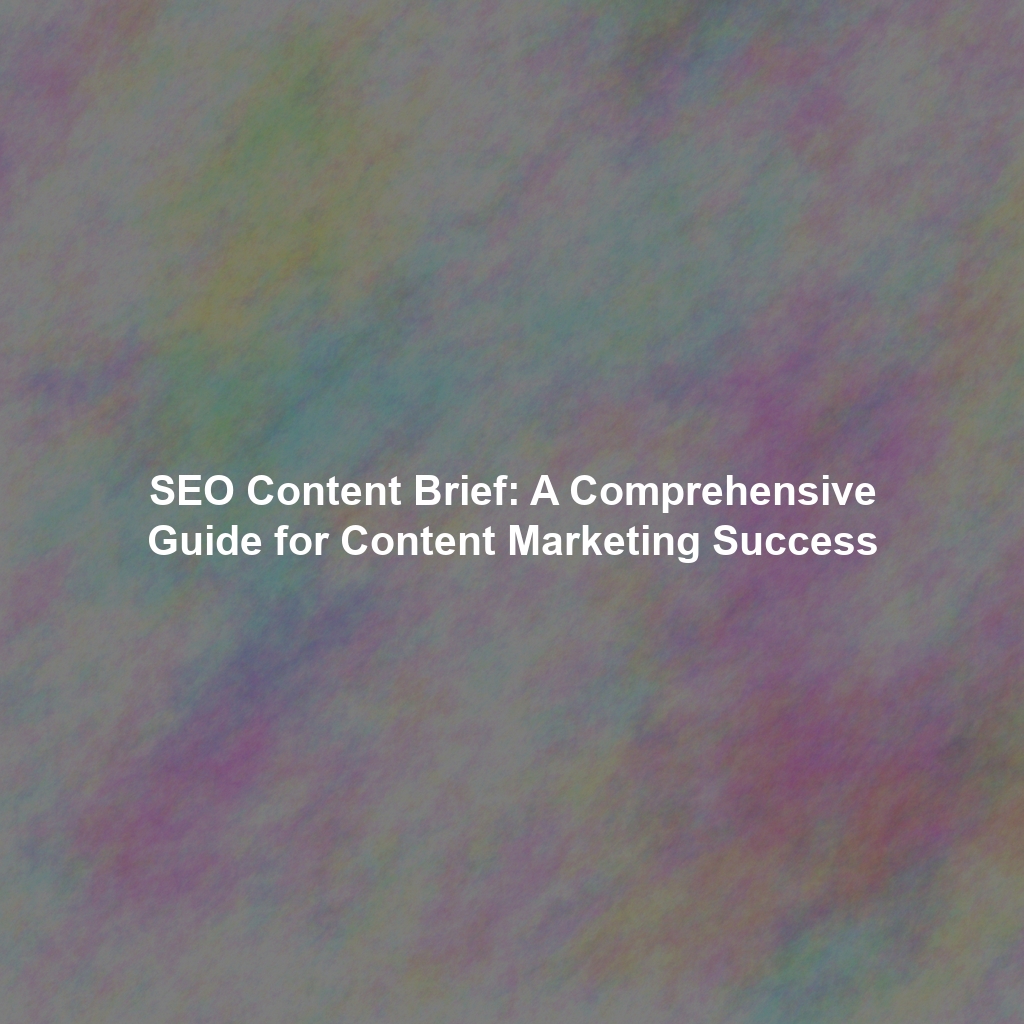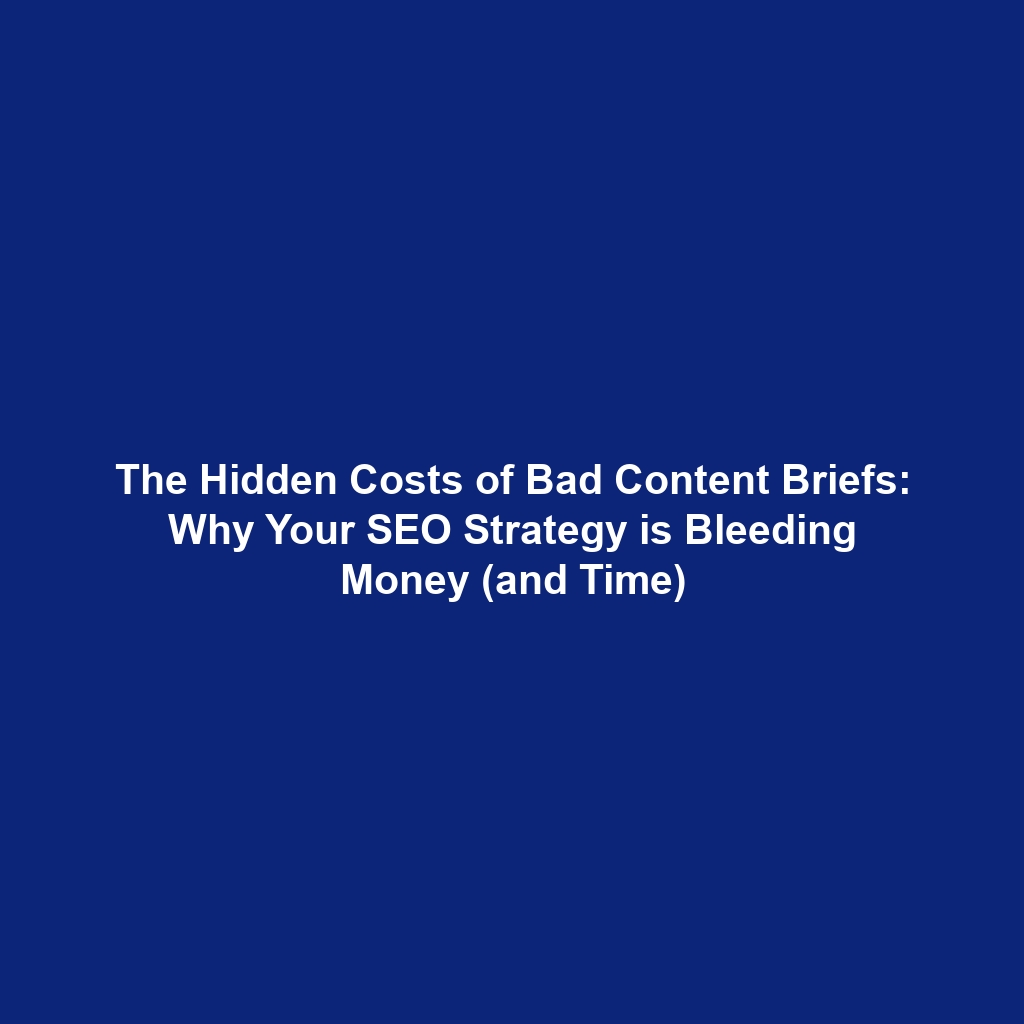Understanding the Power of an SEO Content Brief
In the dynamic world of digital marketing, creating compelling content that ranks well on search engines is paramount. An SEO content brief serves as the blueprint for achieving this goal. It’s a detailed document that outlines the objectives, target audience, keywords, and overall structure of a piece of content, ensuring alignment between SEO strategy and content creation. This comprehensive guide will delve into the intricacies of SEO content briefs, providing actionable insights for SEO professionals, content marketers, and website owners.
Why is an SEO Content Brief Essential?
Without a clear roadmap, content creation can become a haphazard process, leading to wasted resources and disappointing results. An SEO content brief addresses this challenge by providing several key benefits:
Ensuring Content Relevance and Targeting the Right Audience
A well-crafted brief clearly defines the target audience and their needs, ensuring that the content resonates with them. This involves understanding their search intent – what questions are they trying to answer, what problems are they trying to solve? By aligning content with audience intent, you increase engagement and improve dwell time, both positive ranking signals for search engines like Google.
Optimizing for Target Keywords and Search Intent
Keyword research forms the foundation of any successful SEO strategy. The content brief specifies the primary and secondary keywords that the content should target, along with related semantic keywords. It also clarifies the search intent behind these keywords – is it informational, navigational, transactional, or commercial investigation? This ensures that the content is optimized for relevant search queries and has a higher chance of ranking well.
Maintaining Consistency and Brand Voice
For larger content teams, a content brief helps maintain consistency in tone, style, and messaging across all content pieces. It provides guidelines on brand voice, writing style, and formatting, ensuring a cohesive brand experience for the audience. This is crucial for building brand trust and authority.
Improving Content Quality and User Experience
A detailed brief encourages thorough research and planning, leading to higher-quality content that provides value to the reader. It also outlines the desired content structure, including headings, subheadings, and visual elements, to enhance user experience and readability. Content that is easy to consume and provides genuine value is more likely to be shared, linked to, and ultimately, rank higher in search results.
Key Components of an Effective SEO Content Brief
A comprehensive SEO content brief typically includes the following elements:
1. Project Overview and Goals
This section provides a high-level overview of the content piece, including its purpose, target audience, and desired outcomes. What specific goals should the content achieve – generate leads, drive traffic, increase brand awareness, or improve search engine rankings? Defining these goals upfront helps guide the entire content creation process.
2. Target Audience and Buyer Persona
Identifying the target audience is crucial for creating content that resonates. This section should include a detailed description of the ideal reader, including their demographics, interests, pain points, and online behavior. Creating a buyer persona can be a helpful way to visualize and understand the target audience.
3. Keyword Research and Search Intent Analysis
This is the core of the SEO content brief. It outlines the primary keyword, secondary keywords, and related keywords that the content should target. For each keyword, the brief should specify the search intent – informational, navigational, transactional, or commercial investigation. Tools like Google Keyword Planner and Ahrefs can be used for keyword research. Understanding search intent is critical. For instance, a keyword like “best running shoes” likely indicates a commercial investigation intent, requiring a different approach than a keyword like “how to tie running shoes,” which has an informational intent.
4. Content Outline and Structure
A well-structured content outline is essential for readability and user experience. This section should include a detailed outline of the content, including headings, subheadings, and the topics to be covered in each section. The outline should be logical, easy to follow, and optimized for search engines. Consider using a pyramid structure, starting with the most important information and then providing supporting details. Also, consider using schema markup to further enhance your content’s visibility in search results. You can learn more about schema markup on websites like Schema.org.
5. Content Format and Style Guidelines
This section specifies the desired content format – blog post, article, infographic, video, or podcast. It also provides guidelines on writing style, tone, and voice, ensuring consistency with the brand’s overall messaging. For example, is the tone formal or informal? Should the content be technical or easy to understand? Should it be humorous or serious? The content brief should also specify the desired length of the content piece.
6. Call to Action (CTA)
Every piece of content should have a clear call to action, guiding the reader to take the next step. This section should specify the desired action – subscribe to a newsletter, download a resource, request a demo, or make a purchase. The CTA should be relevant to the content and aligned with the overall marketing goals.
7. Examples and References
Providing examples of similar content pieces can be helpful for the writer. This section should include links to relevant articles, blog posts, or videos that can serve as inspiration. It should also include any relevant data or statistics that the writer should incorporate into the content. Consider referencing reputable sources like Statista for statistical data.
8. SEO Guidelines and Optimization Tips
This section provides specific SEO guidelines for the writer, including instructions on keyword placement, internal and external linking, image optimization, and meta description optimization. It should also include any relevant SEO tools or resources that the writer can use.
Creating an SEO Content Brief: A Step-by-Step Guide
Creating an effective SEO content brief involves a systematic approach:
Step 1: Define Your Content Goals and Objectives
What do you want to achieve with this content? Increase traffic, generate leads, build brand awareness? Clearly define your goals upfront.
Step 2: Conduct Thorough Keyword Research
Use keyword research tools to identify relevant keywords with high search volume and low competition. Analyze the search intent behind each keyword.
Step 3: Analyze Your Competitors’ Content
Identify the top-ranking content for your target keywords. Analyze their structure, content, and SEO strategies. This will help you understand what works and what doesn’t.
Step 4: Develop a Detailed Content Outline
Create a logical and easy-to-follow content outline, including headings, subheadings, and the topics to be covered in each section.
Step 5: Write a Clear and Concise Content Brief
Compile all the information you’ve gathered into a clear and concise content brief that the writer can easily understand and follow.
Step 6: Review and Refine the Content Brief
Before sending the brief to the writer, review it carefully to ensure that it’s accurate, complete, and aligned with your goals. Get feedback from other team members if possible.
Tools and Resources for Creating SEO Content Briefs
Several tools and resources can help you create effective SEO content briefs:
- Google Keyword Planner: For keyword research and search volume analysis.
- Brief Buddy: This is the tool I built that is designed to be “stupid easy” to use. You type in two things (topic & target audience) and out comes a perfect, well-researched brief designed from blogs, image creation, video production, social media etc. You can feed it right into ChatGPT to produce content for you too!
- Ahrefs: For keyword research, competitor analysis, and backlink analysis.
- SEMrush: For keyword research, competitor analysis, and site auditing.
- BuzzSumo: For content research and identifying trending topics.
- Google Search Console: For monitoring website performance and identifying keyword opportunities.
Conclusion: Mastering the SEO Content Brief for Digital Marketing Success
An SEO content brief is an indispensable tool for creating content that resonates with your audience and ranks well on search engines. By following the steps outlined in this comprehensive guide, you can create effective content briefs that guide your content creation efforts and drive digital marketing success. Remember that a well-defined strategy based on audience intent and keyword research is the bedrock of successful content marketing. Embrace the power of the SEO content brief and unlock the full potential of your content marketing efforts. Consider the resources offered by Moz for more in-depth SEO strategies.


